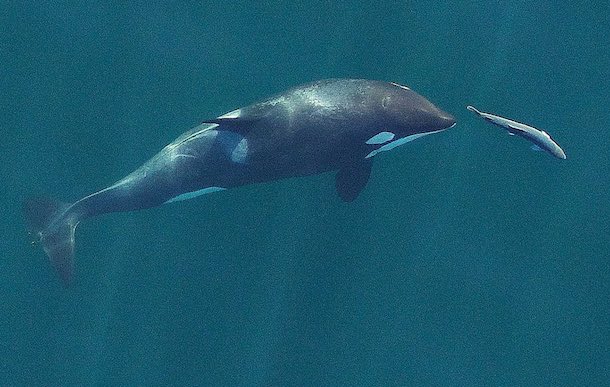forum
library
tutorial
contact

Southern Resident Orcas
Need Action Now
by Sorrel North
San Juan Journal, July 31, 2022
|
the film forum library tutorial contact |

|
Southern Resident Orcas
by Sorrel North
|
Over the last 25 years, Chinook salmon runs have declined precipitously
while commercial whale watching has skyrocketed.
 On July 24, 2018, Southern Resident orca J35 (Tahlequah) gave birth near Victoria, BC. The calf was reported to be alive and swimming but died shortly afterward in a noisy sea, surrounded by multiple vessels. In a heartbreaking display of grief, Tahlequah carried her dead baby on her nose for at least 17 days on a thousand-mile journey. That same year, Governor Inslee's Southern Resident Orca Task Force made a commitment to "bold action" on behalf of the endangered orcas. Among other recommendations, the Task Force called for a three-to-five-year suspension of whale watching.
On July 24, 2018, Southern Resident orca J35 (Tahlequah) gave birth near Victoria, BC. The calf was reported to be alive and swimming but died shortly afterward in a noisy sea, surrounded by multiple vessels. In a heartbreaking display of grief, Tahlequah carried her dead baby on her nose for at least 17 days on a thousand-mile journey. That same year, Governor Inslee's Southern Resident Orca Task Force made a commitment to "bold action" on behalf of the endangered orcas. Among other recommendations, the Task Force called for a three-to-five-year suspension of whale watching.
Four years later, the orca population is in worse shape than ever. Their condition is so dire, on June 30 the Washington State Department of Fish and Wildlife (WDFW) issued an emergency order to prevent commercial whale-watching vessels from approaching the Southern Residents within 1/2 nautical mile. One would think that whale watchers, the self-proclaimed "sentinels" of the endangered orcas, would want this struggling population to have every opportunity to forage unimpeded by vessel noise and disturbance. But no.
The whale watching industry has instead used its financial and political clout to overturn every form of protection recommended by experts that involves allowing the whales to forage successfully. In 2018, Pacific Whale Watching Association hired a lobbyist to convince legislators that a suspension of whale watching was unnecessary. The industry also whittled down a recommended 650-yard distance setback to 300 yards. In 2019, thousands of San Juan County citizens supported a ballot initiative that would have legalized the 650-yard distance setback. Again, whale watchers went on the attack and successfully sued initiative sponsors and the county.
Key findings from a recent study conducted by the National Oceanic and Atmospheric Administration concluded that boat traffic within 400 yards of Southern Resident killer whales interrupts their foraging, often leading female whales to cease feeding altogether. According to lead researcher Marla Holt, the outsize effect of vessel traffic on female whales "could have cascading effects on the ability to meet energetic requirements to support reproductive efforts." Dozens of previous studies have confirmed the detrimental effects of vessel noise and disturbance.
Over the last 25 years, Chinook salmon runs have declined precipitously while commercial whale watching has skyrocketed. PWWA and its supporters, including researchers who enjoy unfettered access to the whales, have claimed for years that the decline of the endangered orca population is due entirely to a lack of fish. While they deflect attention toward the removal of the Snake River dams (a crucial endeavor, but one that will likely take decades to achieve) the orcas are facing rapid extinction through illness and starvation. It's a truly dismal state of affairs when whale watchers have to literally be ordered by law to allow the whales to forage unimpeded in their core critical feeding habitat.
During the pandemic summer of 2020, whale watching in the San Juan Islands was shut down. The following spring, the Southern Residents were noted by researchers to be in the best condition in a decade -- despite poor Chinook runs. During the summer of 2021, whale watchers resumed approaching the orcas within 300 yards, fully aware they were causing the whales to cease feeding. Currently, 12 orcas are in vulnerable condition and, according to Julie Watson, orca policy leader for WDFW, have a much higher likelihood of dying in the next several months.
Four years after the Orca Task Force recommended a suspension of whale watching, WDFW has issued an emergency order. We can only hope it is not too little, too late.
learn more on topics covered in the film
see the video
read the script
learn the songs
discussion forum
